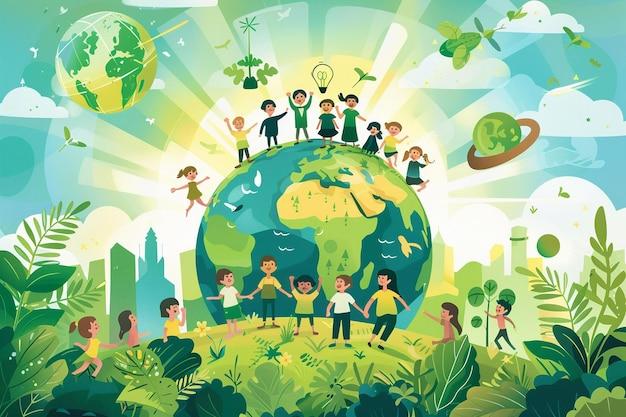EdTech Meets Environmental Education: Shaping Sustainable Learning for a Greener Future
The digital revolution is transforming every aspect of our lives, and education is no exception. As environmental concerns become increasingly urgent, the intersection of EdTech and environmental education presents a promising avenue for creating more sustainable learning environments. This fusion not only makes learning more engaging and interactive but also empowers students to become agents of change for a greener planet.
why EdTech is Vital for Environmental Education
Modern educational technology, or EdTech, offers innovative solutions to conventional learning challenges. When integrated with environmental education, edtech can help students understand complex environmental issues such as climate change, biodiversity loss, and resource depletion in ways that are interactive and relatable.
- Accessible Learning: Digital platforms expand access to environmental education for all, breaking down geographical and socioeconomic barriers.
- Immersive Content: Leveraging visualizations, interactive simulations, and virtual field trips enables deeper comprehension of environmental concepts.
- Practical Skill-Building: Students learn sustainability practices through game-based learning and problem-solving activities embedded in digital curricula.
- Data-Driven insights: Teachers can utilize data analytics to monitor student progress and personalize learning for better outcomes.
Key Benefits of Integrating EdTech in Sustainable Learning
Embracing EdTech for environmental education brings several advantages, both for learners and the planet. Here’s how:
1. Personalized and Adaptive Learning Experiences
With artificial intelligence (AI) and adaptive learning platforms, EdTech tailors educational content to individual needs. Environmental education becomes more relevant when students follow personalized pathways based on their skills, interests, and local community issues.
2. Engaging, Interactive Teaching Methods
Using gamification, AR/VR simulations, and multimedia storytelling enables students to explore ecosystems, witness climate change impacts, or manage virtual cities with ecological challenges. These hands-on approaches foster a deeper emotional connection to sustainability topics.
3. Scalable Outreach and Collaboration
Cloud-based EdTech platforms connect students, educators, and experts worldwide. This global collaboration encourages sharing best practices, problem-solving across borders, and building a generation of informed global citizens committed to sustainable advancement.
4. Reduced Environmental Footprint
Beyond teaching sustainability, EdTech itself can help minimize waste. Digital textbooks, e-exams, and online classrooms reduce paper consumption and commuting, supporting greener academic operations.
Case Studies: EdTech empowering Environmental Education
To illustrate the powerful synergy between technology and environmental learning, consider the following examples from around the globe:
Eco-Schools’ Global Learning Platform
The Eco-Schools program utilizes a robust digital platform enabling schools worldwide to participate in projects, track their progress, and share green success stories. Interactive modules help students learn about recycling,energy conservation,and biodiversity through real-world challenges and peer collaboration.
WWF’s Wild Classroom
The World Wildlife Fund’s Wild Classroom provides educators with digital toolkits, virtual lessons, and immersive educational resources focused on wildlife conservation and climate action. The platform engages students with augmented reality (AR) experiences and sustainability simulations.
Virtual Reality Expeditions by Google Expeditions
Google Expeditions offers virtual reality field trips where students can explore oceans,rainforests,and threatened habitats firsthand—without leaving the classroom. This not only overcomes logistical limitations but also sparks a strong appreciation for the natural world and the urgent need for its protection.
First-Hand Experience: Teachers and Students Share Their Stories
Educators and learners who have embraced the fusion of EdTech and environmental education recount transformative experiences:
“when I introduced VR expeditions on rainforest ecosystems, my students were in awe. They could see the delicate balance of nature and understood the impact of deforestation far better than from a textbook. This has inspired our class to launch a local tree-planting initiative.”
“Participating in an international eco-hackathon through an online platform helped me connect with students from five continents. together, we designed mobile apps to reduce plastic usage in our communities. It was empowering to collaborate on real solutions using technology.”
Practical Tips for Implementing EdTech in environmental Education
Ready to blend technology with sustainability learning? Here are actionable tips for schools, educators, and eco-conscious parents:
- Start with Digital Content: Use free, vetted resources such as open-source curricula, interactive videos, and online labs focused on environmental topics.
- Leverage Gamification: Incorporate eco-themed games and challenges to make learning about recycling, energy use, or conservation engaging and fun.
- Embrace Virtual Field Trips: Use AR/VR-based platforms to “visit” national parks, marine reserves, or renewable energy installations.
- Encourage Collaborative Projects: Utilize cloud-based apps for group projects or international partnerships addressing local ecological challenges.
- Monitor and Assess Impact: Use learning analytics dashboards to track students’ sustainability knowledge and eco-amiable behavior changes.
- Stay Updated: Engage in continual professional development through webinars and EdTech forums focused on environmental themes.
The Future of Green Education: Trends to Watch
The fusion of EdTech and environmental education is rapidly evolving. Watch for these trends shaping sustainable learning in the years ahead:
- AI-Powered Environmental Modeling: Students will use AI tools to predict the impacts of local and global environmental policies.
- Blockchain for Sustainability Certification: Blockchain technology may secure the tracking and validation of sustainable school practices and student achievements.
- Outdoor-EdTech Hybrids: increasingly, curricula will blend hands-on ecological projects with digital reflection and collaboration tools.
- Social Media Advocacy Platforms: Youth-driven platforms will empower students to organize digital campaigns and environmental activism.
Conclusion: Empowering the Next Generation for a Greener Tomorrow
The convergence of EdTech and environmental education is a game-changer for sustainable learning. by making eco-literacy accessible, engaging, and actionable, technology is nurturing a new generation of eco-conscious leaders. As schools, parents, and communities invest in smarter, greener educational practices, we pave the way for meaningful change—locally and globally.
in shaping curricula and strategies for the future, let us remember: sustainable learning is not just about technology or content, but about inspiring lifelong obligation for the environment. Together, we can create classrooms—and a world—that value both innovation and our planet’s wellbeing.

